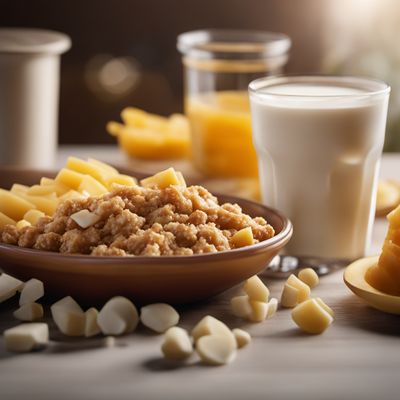
Ingredient
Ready-to-eat meal for infants and young children
Nourishing Delights for Little Ones: Ready-to-Eat Meals for Infants and Young Children
These ready-to-eat meals are carefully crafted to provide a balanced combination of essential nutrients, vitamins, and minerals necessary for the healthy development of infants and young children. They are made with high-quality ingredients and are often fortified with iron, calcium, and other vital nutrients. The meals come in various flavors and textures, catering to different stages of a child's development. They are typically packaged in small, portion-controlled containers, making them easy to serve and ideal for on-the-go parents.
Origins and history
The concept of ready-to-eat meals for infants and young children emerged as a response to the growing demand for convenient and nutritious options for busy parents. These meals have evolved over time to meet the changing dietary recommendations and preferences of parents and healthcare professionals. The development of these meals involves extensive research and collaboration between nutritionists, pediatricians, and food scientists to ensure they meet the specific nutritional needs of growing children.
Nutritional information
These meals are packed with essential nutrients, including protein, carbohydrates, healthy fats, vitamins, and minerals. They are often fortified with iron, calcium, and other key nutrients necessary for the healthy growth and development of infants and young children.
Allergens
It is important to carefully read the labels of ready-to-eat meals for infants and young children, as some may contain common allergens such as milk, soy, wheat, or eggs. Parents should consult with their pediatrician if they have concerns about potential allergens.
How to select
When selecting ready-to-eat meals for infants and young children, it is important to choose reputable brands that prioritize quality and safety. Look for meals that are labeled as age-appropriate and meet the specific dietary needs of your child. Check the expiration date and ensure that the packaging is intact and undamaged.
Storage recommendations
Ready-to-eat meals for infants and young children should be stored according to the manufacturer's instructions. Typically, they should be kept in a cool, dry place away from direct sunlight. Once opened, any remaining portion should be refrigerated and consumed within the recommended timeframe to maintain freshness and quality.
How to produce
Ready-to-eat meals for infants and young children are typically produced by specialized manufacturers who follow strict guidelines and regulations to ensure the safety and quality of the products. Producing these meals at home requires extensive knowledge of infant and child nutrition, as well as proper food handling and preparation techniques. It is recommended to consult with a pediatrician or nutritionist before attempting to produce homemade meals for infants and young children.
Preparation tips
Ready-to-eat meals for infants and young children are designed to be served as is, without the need for additional cooking or preparation. However, it is important to follow the instructions on the packaging regarding heating or serving temperature. Always check the temperature of the meal before serving to ensure it is not too hot for the child. Additionally, parents can enhance the sensory experience by serving the meals in colorful bowls or using child-friendly utensils.
Culinary uses
Ready-to-eat meals for infants and young children are specifically formulated to be complete meals on their own. They are commonly used as a convenient option for busy parents or as a backup when homemade meals are not available. These meals can be served as a main course or as a snack, depending on the child's age and dietary needs.
Availability
Ready-to-eat meals for infants and young children are widely available in grocery stores, supermarkets, and online retailers. They can be found in the baby food section or in specialized sections dedicated to infant and child nutrition.
More ingredients from this category

Ready-to-eat mixed meal for children
Nutrition-packed Delights for Little Ones

Ready-to-eat dairy-based meal for children
Convenient and Nutritious: Ready-to-Eat Dairy-Based Meal for Children

Ready-to-eat meat-based meal for children
Wholesome Delights: Nutritious and Convenient Meat-Based Meals for Kids

Ready-to-eat cereal-based meal for children
Wholesome Delights: Nourishing Cereal Meals for Growing Kids

Ready-to-eat fruit-based meal for children
"Fruity Delights: A Nutritious Meal for Little Ones"

Ready-to-eat vegetable-based meal for children
Wholesome Delights: Nutrient-Packed Meals for Little Ones

Ready-to-eat fish-based meal for children
Ocean Delights: A Nutritious and Delicious Meal for Little Ones